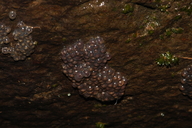|
Sachatamia albomaculata (Taylor, 1949)
Yellow-flecked Cascade Glassfrog White-spotted glassfrog, Rana de Cristal de Cascada, Rana de cristal de puntos blancos | family: Centrolenidae subfamily: Centroleninae genus: Sachatamia |
 © 2005 Robert Puschendorf (1 of 28) |
|
|
|
Description The head is as wide as it is long, and rounded when viewed dorsally (Savage 2002). The snout is rounded in profile (Savage 2002). Eyes are large, with gray-gold irises and black reticula, and the pupils are horizontal (Savage 2002). The dorsal skin is granular, with widely scattered bumps (Savage 2002). There is a fleshy fold on the forearm, along the posterior lower edge (Savage 2002). Finger and toe disks are present and truncate (Savage 2002). The outer fingers are webbed, and the toes are moderately webbed (Savage 2002). Males have white nuptial pads on the thumbs (Savage 2002). Distribution and Habitat Country distribution from AmphibiaWeb's database: Colombia, Costa Rica, Ecuador, Honduras, Panama
Life History, Abundance, Activity, and Special Behaviors Trends and Threats Comments The karyotype is 2N=20 (Duellman 1967). A Spanish-language species account can be found at the website of Instituto Nacional de Biodiversidad (INBio).
References
Duellman, W. E. (1967). ''Additional studies of chromosomes of anuran amphibians.'' Systematic Zoology, 16(1), 38-43. Guyer, C., and Donnelly, M. A. (2005). Amphibians and Reptiles of La Selva, Costa Rica and the Caribbean Slope: A Comprehensive Guide. University of California Press, Berkeley. Savage, J. M. (2002). The Amphibians and Reptiles of Costa Rica:a herpetofauna between two continents, between two seas. University of Chicago Press, Chicago, Illinois, USA and London. Originally submitted by: Peera Chantasirivisal (first posted 2005-12-06) Edited by: Keith Lui (2011-10-05) Species Account Citation: AmphibiaWeb 2011 Sachatamia albomaculata: Yellow-flecked Cascade Glassfrog White-spotted glassfrog <https://amphibiaweb.org/species/1750> University of California, Berkeley, CA, USA. Accessed May 31, 2025.
Feedback or comments about this page.
Citation: AmphibiaWeb. 2025. <https://amphibiaweb.org> University of California, Berkeley, CA, USA. Accessed 31 May 2025. AmphibiaWeb's policy on data use. |




 Map of Life
Map of Life